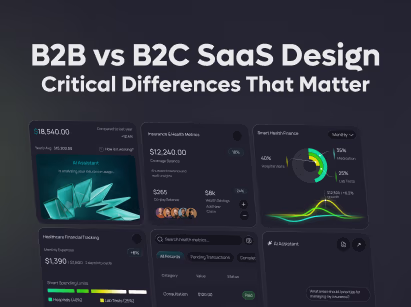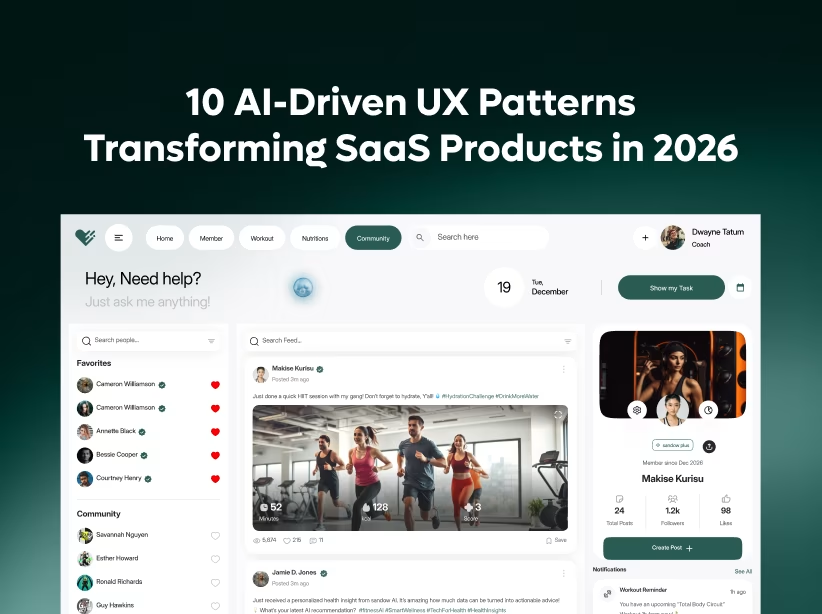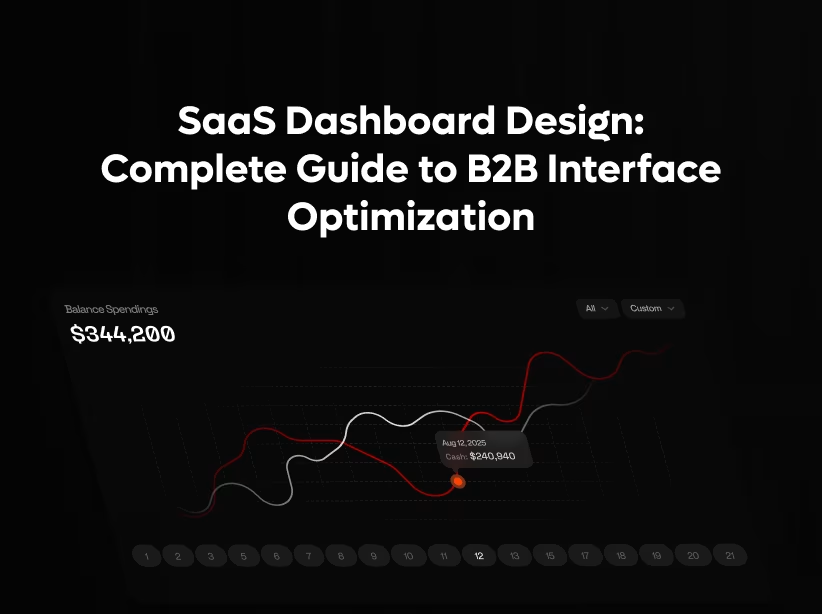Table of Contents
- The State of AI Integration in SaaS: 2025 Reality
- Strategic Framework: Where to Integrate AI in Your SaaS
- Building Intelligent User Interfaces: Design Principles
- Ethical AI Design: Principles and Practices
- Measuring AI Feature Impact: Metrics That Matter
- Implementation Roadmap: From Strategy to Production
- Ready to Integrate AI Ethically and Effectively?

Integrating AI into your SaaS product is no longer optional—it's a competitive necessity. Yet most companies struggle with the critical question: How do we implement AI that genuinely improves user experience while maintaining ethical standards and measuring real impact?
The difference between successful AI integration and expensive failure lies in strategic implementation guided by ethical principles and validated through concrete metrics.
This comprehensive guide reveals how to integrate AI into SaaS products effectively, build truly intelligent user interfaces, establish ethical design frameworks, and measure the actual business impact of AI features.
The State of AI Integration in SaaS: 2025 Reality
AI integration has matured from experimental feature to core infrastructure. Understanding the current landscape guides strategic decisions.
Adoption Statistics: 78% of SaaS companies now incorporate some form of AI into their products, up from 31% in 2022. However, only 23% report high satisfaction with their AI implementation—highlighting the gap between adoption and effective execution.
User Expectations: 68% of SaaS users now expect AI-powered features like intelligent recommendations, automated workflows, and conversational interfaces. Products lacking these capabilities appear outdated compared to AI-enhanced competitors.
Investment Trends: Average SaaS companies allocate 15-25% of R&D budgets to AI integration, with leading companies investing 30%+. ROI varies dramatically—companies with strategic, ethical implementations see 3-5x returns, while rushed implementations often destroy value.
The Implementation Challenge: Technical complexity isn't the primary barrier anymore. The real challenges are: choosing which AI features deliver genuine value, designing ethical AI experiences users trust, measuring actual impact versus hype, and scaling AI capabilities as products grow.
Strategic Framework: Where to Integrate AI in Your SaaS
Not every feature benefits from AI. Strategic integration focuses on areas delivering maximum user value and business impact.
High-Impact Integration Opportunities
1. Onboarding and Activation
AI Application: Personalized onboarding paths adapting to user role, experience level, and goals. Predictive guidance surfacing features most relevant to each user.
Business Impact: SaaS implementing AI-driven onboarding see 35-52% improvement in activation rates and 28% faster time-to-value.
Implementation Priority: High—directly impacts conversion and retention.
2. Search and Discovery
AI Application: Natural language search understanding user intent beyond keywords. Semantic search finding relevant content even with imperfect queries. Intelligent filtering and recommendations.
Business Impact: AI-enhanced search increases feature adoption by 43% as users discover capabilities they didn't know existed.
Implementation Priority: High—search is gateway to product value.
3. Workflow Automation
AI Application: Detecting repetitive tasks and suggesting automation. Predicting next actions in common workflows. Auto-completing forms and data entry based on patterns.
Business Impact: Workflow automation features show 41% increase in power user engagement and 38% reduction in time spent on repetitive tasks.
Implementation Priority: Medium-High—strong value for frequent users.
4. Content Generation
AI Application: Writing assistance, document summarization, template generation, code completion, design suggestions—any content creation within your product.
Business Impact: AI content generation accelerates creation by 45-60% while maintaining 85-90% user satisfaction with quality.
Implementation Priority: Medium—depends on product category.
5. Intelligent Analytics
AI Application: Automated insights generation, anomaly detection, predictive analytics, natural language data querying.
Business Impact: AI analytics features increase dashboard usage by 67% as non-technical users extract insights independently.
Implementation Priority: Medium—powerful for data-heavy products.
6. Customer Support
AI Application: Chatbots with genuine understanding, automated ticket routing, suggested responses for support agents, predictive issue resolution.
Business Impact: AI support reduces ticket volume by 30-45% while improving satisfaction scores by 18-25 points.
Implementation Priority: Medium—strong ROI but less core to product.
Building Intelligent User Interfaces: Design Principles
AI-powered features require different interface design approaches than traditional functionality.
Principle 1: Transparency Over Magic
The Problem: "Black box" AI that works mysteriously erodes trust. Users accept AI suggestions more readily when understanding the reasoning.
Design Solution: Always explain AI decisions clearly. "We recommend this because..." not just "Recommended for you." Show confidence levels: "87% confident" versus "Possible match." Provide access to underlying data informing suggestions.
Real Example: GitHub Copilot shows code suggestions with confidence indicators. Users accept high-confidence suggestions quickly while reviewing low-confidence ones carefully.
Implementation: Add "Why this suggestion?" tooltips. Display simplified reasoning: "Based on your usage of features X and Y, users like you typically need Z." Provide documentation about AI model capabilities and limitations.
Principle 2: Human Control and Override
The Problem: Automation that users can't control feels oppressive. Even accurate AI benefits from human oversight for edge cases and personal preferences.
Design Solution: AI should suggest, not dictate. Always provide manual override options. Make it easy to "undo" AI actions. Allow users to teach AI their preferences through feedback.
Real Example: Gmail's Smart Compose suggests completions but never auto-sends. Grammarly suggests improvements but never changes text without explicit acceptance.
Implementation: Design clear accept/reject UI for AI suggestions. Implement "Not interested" or "Show less like this" feedback options. Provide settings controlling AI aggressiveness. Maintain traditional manual workflows alongside AI assistance.
Principle 3: Progressive Disclosure of Intelligence
The Problem: Overwhelming users with AI capabilities upfront creates confusion. Too many "smart" features competing for attention reduces overall effectiveness.
Design Solution: Introduce AI features gradually as users demonstrate readiness. Start with basic functionality, revealing intelligent capabilities after users understand fundamentals.
Real Example: Notion progressively reveals AI features. New users see basic editing. As they create more documents, AI suggestions for templates, writing assistance, and automation surface contextually.
Implementation: Implement staged feature rollout based on user maturity. Use contextual introduction—show AI features when users perform relevant tasks manually. Track feature awareness and adoption metrics determining introduction timing.
Principle 4: Graceful Failure Handling
The Problem: AI makes mistakes inevitably. Poor error handling destroys trust permanently. Users judge AI by worst failures, not average performance.
Design Solution: Design explicitly for AI failure scenarios. Communicate confidence levels honestly. Provide easy error reporting. Never hide failures—acknowledge and learn from them.
Real Example: Translation services explicitly note when confidence is low. AI assistants say "I'm not sure" rather than inventing plausible-sounding wrong answers.
Implementation: Show confidence scores for predictions. Design gentle error states: "I couldn't find what you're looking for. Can you rephrase?" not "Error 404." Implement one-click error reporting feeding improvement pipelines. Track error rates and patterns systematically.
Principle 5: Adaptive Learning
The Problem: Static AI that never improves frustrates users who provide feedback expecting the system to learn.
Design Solution: Implement feedback loops where user corrections improve AI performance over time. Make learning visible—users appreciate seeing AI adapt to their preferences.
Real Example: Spotify's recommendations improve continuously from listening behavior and explicit feedback. Users notice personalization quality increasing over time.
Implementation: Capture implicit feedback (acceptances, rejections, modifications). Collect explicit feedback through simple thumbs up/down. Retrain models regularly incorporating new feedback data. Communicate improvements: "Your recommendations improved based on recent feedback."
Ethical AI Design: Principles and Practices
Ethical considerations aren't optional—they're essential for building AI users trust and regulatory bodies accept.
Ethical Principle 1: Fairness and Bias Mitigation
The Challenge: AI models inherit biases from training data, potentially discriminating against protected groups or perpetuating societal inequities.
Design Practice:
- Audit training data for representation across demographics
- Test AI performance across user segments identifying disparate outcomes
- Implement bias detection monitoring ongoing AI behavior
- Diversify training data addressing identified gaps
- Involve diverse teams in AI development and testing
Real Implementation: Hiring platforms scrutinize AI screening for demographic bias. Financial services test lending AI across protected classes. Healthcare AI validates performance across diverse patient populations.
Orbix Approach: We conduct bias audits for all AI implementations, testing across user segments and use cases. Our diverse design team brings multiple perspectives identifying potential fairness issues early.
Ethical Principle 2: Privacy and Data Protection
The Challenge: AI requires data—often lots of it. Balancing AI capability with user privacy demands careful design choices.
Design Practice:
- Collect minimum data necessary for AI functionality
- Implement data minimization and retention limits
- Provide clear privacy policies specifically addressing AI data usage
- Offer meaningful privacy controls beyond binary accept/reject
- Consider federated learning and differential privacy techniques
- Never sell or share user data powering AI features
Real Implementation: Apple emphasizes on-device AI processing protecting privacy. Signal uses AI without server-side data collection. Privacy-focused companies use anonymization and aggregation enabling AI while protecting individuals.
User Control: Design granular privacy controls: "Use my data to improve suggestions" versus "Use my data to improve the product generally" versus "Don't use my data." Many users accept personalization but reject broader data usage.
Ethical Principle 3: Transparency and Explainability
The Challenge: Complex AI models function as "black boxes" even to creators. Users deserve understanding of how AI affecting them works.
Design Practice:
- Provide clear explanations of AI functionality in plain language
- Disclose when AI is making decisions versus humans
- Explain individual AI decisions when requested ("Why did you recommend this?")
- Document AI limitations and known failure modes
- Make model documentation accessible to interested users
Regulatory Context: EU AI Act and similar regulations mandate transparency for high-risk AI systems. Proactive transparency builds trust and ensures compliance.
Implementation Tiers:
- Basic: "We use AI to personalize your experience"
- Intermediate: "AI analyzes your usage patterns to recommend features"
- Advanced: Detailed documentation of models, data sources, and decision logic
Ethical Principle 4: User Autonomy and Consent
The Challenge: AI can manipulate user behavior subtly. Ethical design respects user agency and decision-making autonomy.
Design Practice:
- Obtain informed consent before AI processing personal data
- Design AI as advisory, not directive—suggest, don't coerce
- Avoid dark patterns leveraging AI for manipulation
- Enable users to disable AI features entirely
- Never hide AI usage—always disclose when AI is active
Manipulation Avoidance: Don't use AI to identify psychological vulnerabilities and exploit them. Don't optimize purely for engagement if harmful to users. Don't A/B test AI features designed to be addictive.
Consent Best Practices: Provide meaningful choice during onboarding. Allow granular feature-level consent, not all-or-nothing. Make consent withdrawal easy as initial acceptance. Respect preferences consistently across product.
Ethical Principle 5: Accessibility and Inclusion
The Challenge: AI features must work for all users, including those with disabilities and neurodiversities.
Design Practice:
- Ensure AI interfaces meet WCAG accessibility standards
- Test AI with assistive technologies (screen readers, voice control)
- Consider cognitive inclusion—AI shouldn't confuse or overwhelm
- Provide alternative non-AI workflows for users preferring them
- Design for global audiences considering cultural contexts
Cognitive Consideration: Some users with ADHD, autism, or anxiety disorders may find AI features overwhelming or unpredictable. Always provide control and predictability options.
Ethical Principle 6: Environmental Responsibility
The Challenge: AI training and inference consume significant energy. Ethical AI considers environmental impact.
Design Practice:
- Optimize models for efficiency reducing computational requirements
- Use renewable energy for AI infrastructure when possible
- Consider on-device processing reducing data center load
- Balance AI capability against environmental cost
- Be transparent about AI environmental footprint
Practical Steps: Use smaller models when accuracy difference is minimal. Implement edge computing for simple AI tasks. Cache predictions reducing redundant computation. Monitor and report AI energy usage.
Measuring AI Feature Impact: Metrics That Matter
AI implementation without measurement wastes resources. Track these metrics proving (or disproving) AI value.
User Engagement Metrics
AI Feature Adoption Rate
- Percentage of users engaging with AI features
- Target: 40-60% adoption within 3 months for core AI features
- Low adoption signals poor discoverability or unclear value
AI Feature Usage Frequency
- How often users leverage AI capabilities
- Daily active AI users / total daily active users
- High frequency indicates genuine utility
AI Suggestion Acceptance Rate
- Percentage of AI recommendations users accept
- Target: 60-80% for good AI
- Low acceptance indicates poor relevance or trust issues
Efficiency Metrics
Time Savings
- Reduction in time to complete tasks with AI versus without
- Measure actual usage time, not theoretical calculations
- Target: 30-50% time reduction for automation features
Error Rate Reduction
- Decrease in mistakes when using AI assistance
- Particularly relevant for data entry and content creation
- Target: 20-40% fewer errors
Task Completion Rate
- Percentage of workflows successfully completed
- AI should increase completion, not abandon rates
- Target: 10-20% improvement
Business Impact Metrics
Conversion Rate Changes
- Impact of AI features on trial-to-paid conversion
- Measure AI user cohort versus non-AI cohort
- Positive impact validates AI investment
Retention Improvement
- Do AI users churn less than non-AI users?
- Control for other variables (usage frequency, tenure)
- Target: 15-25% better retention for AI users
Customer Lifetime Value (LTV)
- AI users should demonstrate higher LTV through longer retention and expansion
- Track over time—AI value often compounds
- Target: 20-35% higher LTV
Net Promoter Score (NPS)
- Do AI features improve user satisfaction and likelihood to recommend?
- Segment NPS by AI feature usage
- Target: 5-10 point NPS improvement
AI Quality Metrics
Prediction Accuracy
- Percentage of AI predictions that are correct
- Varies by use case—recommendation systems differ from fraud detection
- Track accuracy over time ensuring maintenance
False Positive/Negative Rates
- Balance between overly cautious and overly aggressive AI
- Context determines acceptable rates
- Monitor user frustration from false positives
Model Performance Degradation
- AI accuracy declines over time without retraining
- Establish baseline and alert thresholds
- Implement retraining cadence based on degradation speed
Bias Metrics
- Measure AI performance disparities across user segments
- Demographics, geography, usage patterns
- Address significant disparities immediately
ROI Calculation Framework
Total Investment:
- Development costs (engineering, data science, design)
- Infrastructure costs (compute, storage, APIs)
- Ongoing maintenance costs
Total Returns:
- Revenue increase from improved conversion
- Cost savings from automation and efficiency
- Retention value from reduced churn
- Customer acquisition cost reduction
Example Calculation:
Investment: $150,000 development + $2,000 monthly infrastructure Returns:
- +200 conversions monthly × $50 MRR × 24-month LTV = $240,000 annually
- 30% efficiency gain × 5 support staff × $60,000 salary = $90,000 annually
- Total annual return: $330,000
ROI: ($330,000 - $174,000) / $174,000 = 90% first-year ROI
Most well-implemented AI features achieve positive ROI within 6-12 months.
Implementation Roadmap: From Strategy to Production
Phase 1: Strategic Planning (Weeks 1-4)
Activities:
- Identify high-impact integration opportunities
- Define success metrics and targets
- Establish ethical guidelines and review processes
- Assess technical requirements and capabilities
- Create project roadmap and resource plan
Deliverables:
- AI feature prioritization matrix
- Technical architecture design
- Ethical review framework
- Measurement plan with baseline metrics
Phase 2: MVP Development (Weeks 5-12)
Activities:
- Build minimum viable AI feature
- Design ethical user interfaces
- Implement core functionality
- Create measurement instrumentation
- Conduct internal testing
Deliverables:
- Working AI feature prototype
- User interface designs
- Technical documentation
- Testing results and refinements
Phase 3: Beta Testing (Weeks 13-16)
Activities:
- Launch to limited user segment
- Gather qualitative feedback
- Monitor quantitative metrics
- Conduct bias and fairness audits
- Iterate based on learning
Deliverables:
- Beta user feedback summary
- Performance metrics report
- Ethical audit results
- Refinement recommendations
Phase 4: Full Launch (Weeks 17-20)
Activities:
- Progressive rollout to all users
- Monitor metrics closely
- Provide user education and support
- Address issues quickly
- Communicate value clearly
Deliverables:
- Launch communication plan
- Support documentation
- Monitoring dashboard
- Incident response playbook
Phase 5: Optimization (Ongoing)
Activities:
- Continuous metric tracking
- Regular model retraining
- A/B testing improvements
- User feedback incorporation
- Ethical reviews and audits
Deliverables:
- Monthly performance reports
- Quarterly optimization recommendations
- Annual strategic reviews
Ready to Integrate AI Ethically and Effectively?
AI integration done right transforms SaaS products from functional tools into intelligent partners users depend on daily. Done poorly, it wastes resources, frustrates users, and creates technical and ethical debt.
The difference lies in strategic implementation guided by ethical principles and validated through rigorous measurement.
At Orbix, we specialize in ethical AI integration for SaaS products. Our approach combines technical AI expertise with user-centered design and ethical frameworks, delivering intelligent experiences users trust and metrics prove valuable.
Our AI Integration Services:
✓ AI Strategy Development: Identify high-impact integration opportunities aligned with business goals
✓ Ethical AI Framework: Establish principles and practices ensuring responsible AI deployment
✓ Intelligent Interface Design: Create user experiences leveraging AI while maintaining transparency and control
✓ Implementation Support: Technical guidance and execution from MVP to production
✓ Measurement Systems: Comprehensive instrumentation tracking AI feature impact
✓ Continuous Optimization: Ongoing monitoring, testing, and improvement programs
Proven Methodology: Our clients implementing AI features with our ethical framework see 47% average engagement improvement, 38% efficiency gains, and 85%+ user satisfaction with AI capabilities.
Fresh UI/UX Ideas, Straight to Your Inbox





